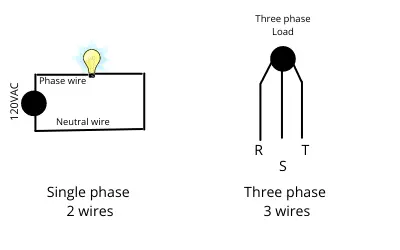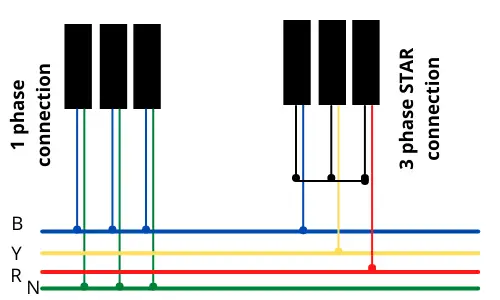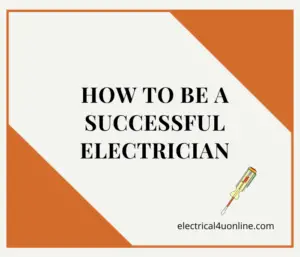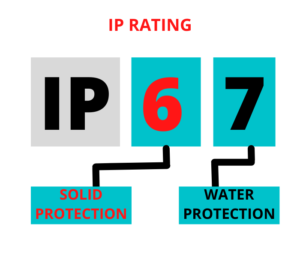The single-phase system is typically employed in settings where smaller loads demand less electrical power. This configuration is commonly utilized in residential and light commercial applications, catering to the needs of modest power consumption.
Conversely, the three-phase system finds application in scenarios necessitating substantial AC power supply, notably in extensive industrial facilities, factories, and various manufacturing units. Its implementation serves the purpose of meeting the heightened power demands characteristic of such large-scale industrial operations.
Table of Contents
Single Phase Vs Three Phase System

Here is a comparison between single-phase and three-phase electrical power systems:
-
Voltage and Power Capacity:
- Single-phase systems typically provide a single alternating current at a specific voltage. They are commonly used for powering household appliances and small-scale electrical equipment.
- Three-phase systems deliver three alternating currents with the same frequency and voltage but with a 120-degree phase difference between them. They are employed in industrial settings and for heavy machinery due to their higher power capacity.
-
Efficiency and Performance:
- Three-phase systems offer higher efficiency and smoother performance compared to single-phase systems, especially for heavy-duty machinery and industrial applications. They deliver a constant power supply, resulting in reduced vibrations and increased motor performance.
- Single-phase systems are suitable for lighter applications and residential use, where the power demands are generally lower.
-
Cost and Complexity:
- Single-phase systems are generally less complex and less expensive to install compared to three-phase systems. They are commonly used in residential areas where the power requirements are relatively low.
- Three-phase systems involve more complex installations and equipment, making them more expensive than single-phase systems. They are primarily used in commercial and industrial settings where higher power demands and smoother performance are necessary.
-
Balancing and Stability:
- Three-phase systems provide a more balanced power supply, leading to improved stability and lower overall losses. They are better equipped to handle heavy and fluctuating loads, ensuring consistent performance across all phases.
- Single-phase systems are susceptible to imbalances and voltage fluctuations, particularly when dealing with heavy loads, which can lead to inefficiencies and potential equipment damage.
-
Motor Applications:
- Three-phase systems are better suited for powering large motors and high-torque industrial machinery due to their higher efficiency and performance. They offer better starting torque and smoother operation.
- Single-phase systems are commonly used for smaller motors and appliances in residential and light commercial settings. They are less efficient for powering heavy machinery and equipment.
Understanding these key differences can help in selecting the appropriate power system for different applications, whether it be for residential, commercial, or industrial purposes. Both single-phase and three-phase systems have their distinct advantages and are tailored to meet specific power requirements.
advantages of 3 phases over a single phase
Three-phase power systems offer several advantages over single-phase systems, especially in industrial and high-power applications. Here are some key advantages of three-phase power over single-phase power:
-
Power output: Three-phase power systems can deliver more power compared to single-phase systems of the same voltage. This is because they have three separate conductors, each providing power, which results in a constant and continuous power transfer.
-
Efficiency: Three-phase motors are generally more efficient than single-phase motors. They can operate at a constant and smooth power supply, which reduces vibrations and improves overall performance. This makes them suitable for high-torque applications, thus increasing overall energy efficiency.
-
Smaller conductors: Three-phase power systems allow for the use of smaller conductors compared to single-phase systems to transmit the same amount of power. This can result in cost savings and reduced material requirements, especially in long-distance power transmission and distribution.
-
Balanced loads: Three-phase power systems can support a more balanced load across all phases, resulting in a more stable power supply. This balance minimizes the neutral current, reduces losses, and ensures efficient power transmission.
-
High starting torque: Three-phase motors have higher starting torque compared to single-phase motors. This makes them well-suited for applications that require high starting torque, such as industrial machinery and heavy-duty equipment.
-
Reliability and smooth operation: Three-phase power systems provide a smoother power output, leading to less fluctuation and improved reliability. This is crucial for applications that require a continuous and stable power supply, minimizing the risk of interruptions and downtime.
-
Lower cost of transmission: Three-phase power systems are more cost-effective for transmitting large amounts of power over long distances. They experience lower energy losses compared to single-phase systems, resulting in reduced transmission costs and improved overall efficiency.
-
Compatibility with three-phase equipment: Many industrial and commercial machines and equipment are designed to operate with three-phase power. Using a three-phase power supply eliminates the need for additional converters or transformers, simplifying the setup and reducing overall equipment costs.
These advantages make three-phase power systems the preferred choice for many industrial, commercial, and high-power applications, where efficiency, reliability, and cost-effectiveness are critical factors.
Can single-phase and three-phase loads run on the same power supply?
Yes, single-phase and three-phase loads can run on the same power supply. Many industrial and commercial setups use a combination of single-phase and three-phase loads, and they can be connected to the same power supply system.
However, it is important to ensure that the power supply can meet the requirements of both types of loads.
To accommodate both types of loads on the same power supply, certain considerations should be taken into account:
-
Balancing the load: It’s crucial to balance the loads across all phases in a three-phase system. This helps in ensuring the stability and efficiency of the overall power supply. Imbalanced loads can lead to issues such as overheating, voltage fluctuations, and equipment damage.
-
Using appropriate transformers: In cases where single-phase and three-phase loads need to be supplied by the same system, transformers may be used to convert the power supply to the required phase configuration. This helps ensure that each type of load receives the appropriate voltage and current.
-
Circuit protection: Proper circuit protection, such as fuses and circuit breakers, should be installed to safeguard both single-phase and three-phase loads from electrical faults, overloads, and short circuits.
-
Considering the power capacity: The power supply should have the capacity to handle the total power demand from both single-phase and three-phase loads. This ensures that the power supply remains stable and reliable under varying load conditions.
By appropriately managing and balancing the power supply, using transformers where necessary, and implementing effective circuit protection, it is possible to run single-phase and three-phase loads on the same power supply without significant issues. However, it’s essential to consult with electrical engineers or professionals to ensure the safe and efficient operation of the system.
Loads for single and three-phase supply
Some loads like heaters have the flexibility of running on both types of power sources. This is a common way for industrial heaters where the heater consists of three separate single-phase heaters, and by connecting them as STAR or DELTA formation we can feed them as one three-phase heater (even star or delta).
By connecting the 3 heaters in series or in parallel as one single-phase heater we can connect this heater to a single-phase source.

If we have 2 power sources, Which one is better Three phase vs single phase?
Assume we have a load that could be run on both single and three-phase sources (like the heater in the above example). Which is better to connect the load on?
- Regarding the power consumption, Three phase vs single phase, The power is the same in both connections. As the load power (the heater) is constant.
- Regarding the cost of installation, Three-phase power needs 3 core wires and 3 pole circuit breakers, and the design of short circuit protection requires a higher short circuit current of the CB. This means higher cost.
Single-phase motor vs three-phase motor
Three-phase motors are more effective, self-starting, need no starting capacitor, need less maintenance compared to 1 phase motors, and always have a higher power factor and higher efficiency than single-phase motors.
| Feature | Single phase | Three phase |
| Number of wires | 2 wires (one phase and neutral) | 3 (3 phases, no neutral)/ 4 wires (3 phases + neutral) |
| Short circuit current | Smaller | Higher |
| Loads | Domestic loads and small industrial loads | Industrial loads |
| Power transmission | Minimum ability of power | Maximum power transmission |
| Efficiency | Less | High |
| Over headlines | Small, and can be inside cities | Very high for safety and outside cities. |
| Voltage levels | Only low voltage | Low, medium, high, and extra high voltages. |
Don’t Leave Empty-Handed!
Install my Free Android App on Google Play:
Electrical Cables Most Common Tables “Cables Tables”
And, my Electrical Calculations App “Fast Electrical Calculator”
Discover more great content by subscribing to My channel
Looking to stay ahead of the game in the world of electrical engineering? Subscribe to my YouTube channel and gain access to exclusive content you won’t find anywhere else!
The staff I recommend
(Amazon Affiliate Links to products I believe are high quality):
- Economy 120 Volt/60Hz AC Power Source – Step-Down Voltage & Frequency Converters 1800W
- UNI-T Digital Multimeter Tester UT139C
- 50-Amp Extension Cord for RV “100ft”
- Voltage Stabilizer 110/220v
- Hair Dryer “best selling“
- TOSHIBA EM131A5C-BS Countertop Microwave Ovens
Disclaimer: This contains affiliate links to Amazon products. I may earn a commission for purchases made through these links.


